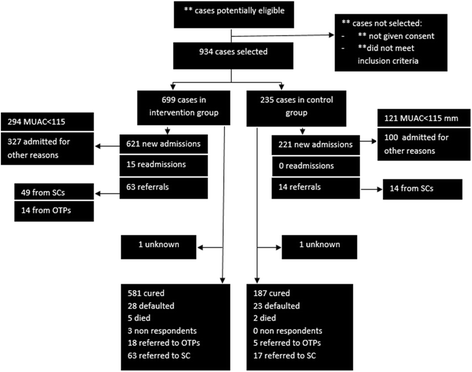The effectiveness of treatment for Severe Acute Malnutrition (SAM) delivered by community health workers compared to a traditional facility based model
- PMID: 29580238
- PMCID: PMC5870488
- DOI: 10.1186/s12913-018-2987-z
The effectiveness of treatment for Severe Acute Malnutrition (SAM) delivered by community health workers compared to a traditional facility based model
Abstract
Background: In most health systems, Community Health Workers (CHWs) identify and screen for severe acute malnutrition (SAM) in the community. This study aimed to investigate the potential of integrating SAM identification and treatment delivered by CHWs, in order to improve the coverage of SAM treatment services.
Methods: This multicentre, randomised intervention study was conducted in Kita, Southwest Mali between February 2015 and February 2016. Treatment for uncomplicated SAM was provided in health facilities in the control area, and by Community Health Workers and health facilities in the intervention area. Clinical outcomes (cure, death and defaulter ratios), treatment coverage and quality of care were examined in both the control and intervention group.
Results: Six hundred ninety nine children were admitted to the intervention group and 235 children to the control group. The intervention group reported cure ratios of 94.2% compared to 88.6% in the control group (risk ratio 1.07 [95% CI 1.01; 1.13]). Defaulter ratios were twice as high in the control group compared to the intervention group (10.8% vs 4.5%; RR 0.42 [95% CI 0.25; 0.71]). Differences in mortality ratios were not statistically significant (0.9% in the intervention group compared to 0.8% in the control group). Coverage rates in December 2015 were 86.7% in intervention group compared to 41.6% in the control (p < 0.0001).
Conclusions: With minimal training, CHWs are able to appropriately treat SAM in the community. Allowing CHWs to treat SAM reduces defaulter ratios without compromising treatment outcomes and can lead to improved access to treatment.
Trial registration: Retrospectively registered in ISRCTN Register with ISRCTN33578874 on March 7th 2018.
Keywords: Child nutrition; Community health workers; Community-based Management of Acute Malnutrition (CMAM); Coverage; Severe acute malnutrition (SAM).
Conflict of interest statement
Ethics approval and consent to participate
The study was approved by the Comité d’Ethique de l’Institut National de Recherche en Santé Publique from Mali (decision n° 03/2015/CE-INRSP). Written informed consent was obtained from all the care takers whose children were part of the study.
Consent for publication
Not applicable
Competing interests
The authors declare that they have no competing interests.
Publisher’s Note
Springer Nature remains neutral with regard to jurisdictional claims in published maps and institutional affiliations.
Figures
References
-
- WHO | UNICEF-WHO-The World Bank. Joint child malnutrition estimates - Levels and trends. WHO. http://www.who.int/entity/nutgrowthdb/estimates/en/index.html. Accessed 26 Aug 2016.
-
- GBD Results Tool | GHDx [Internet]. Available from: http://ghdx.healthdata.org/gbd-results-tool?params=querytool-permalink/d.... [cited 2017 Sep 12].
-
- UNICEF/Coverage Monitoring Network/ACF, International. The state of global SAM Management coverage. 2012. https://www.actionagainsthunger.org/publication/2013/10/state-global-sam.... Accessed 25 Aug 2016.
Publication types
MeSH terms
Associated data
LinkOut - more resources
Full Text Sources
Other Literature Sources
Medical



